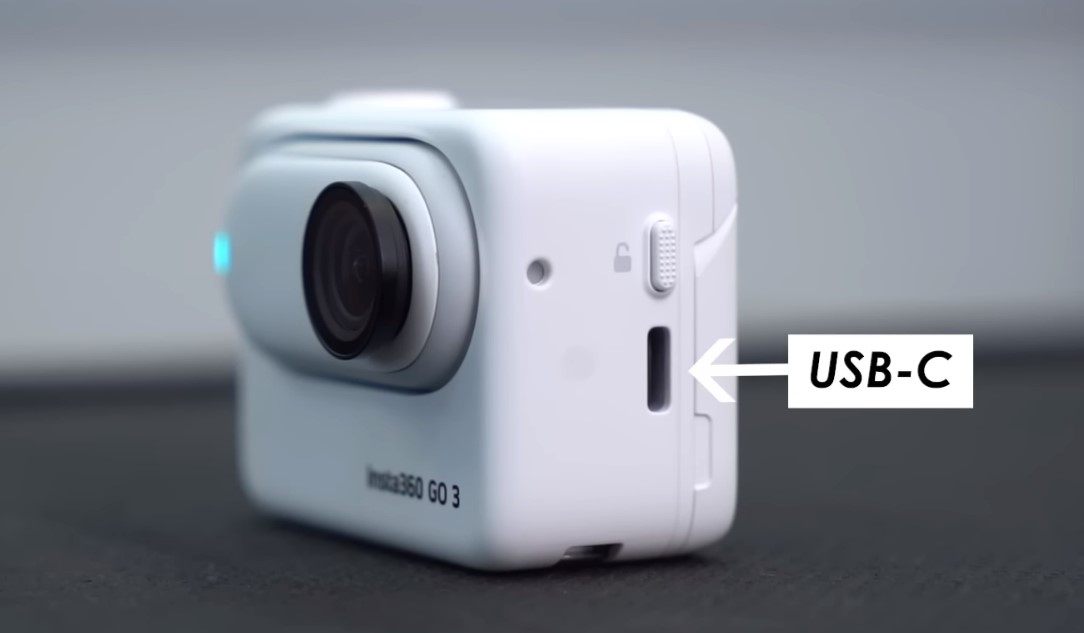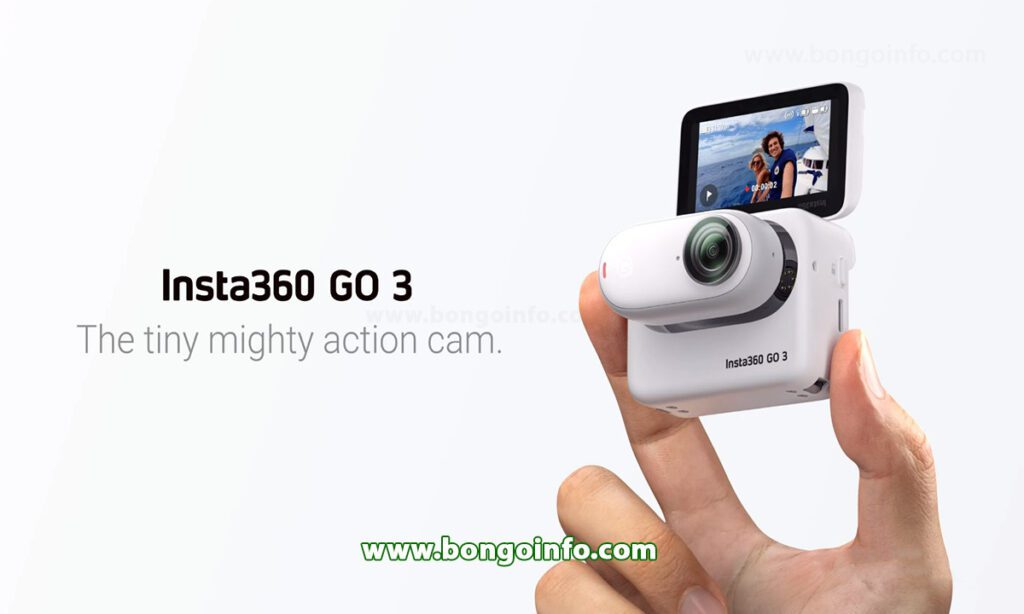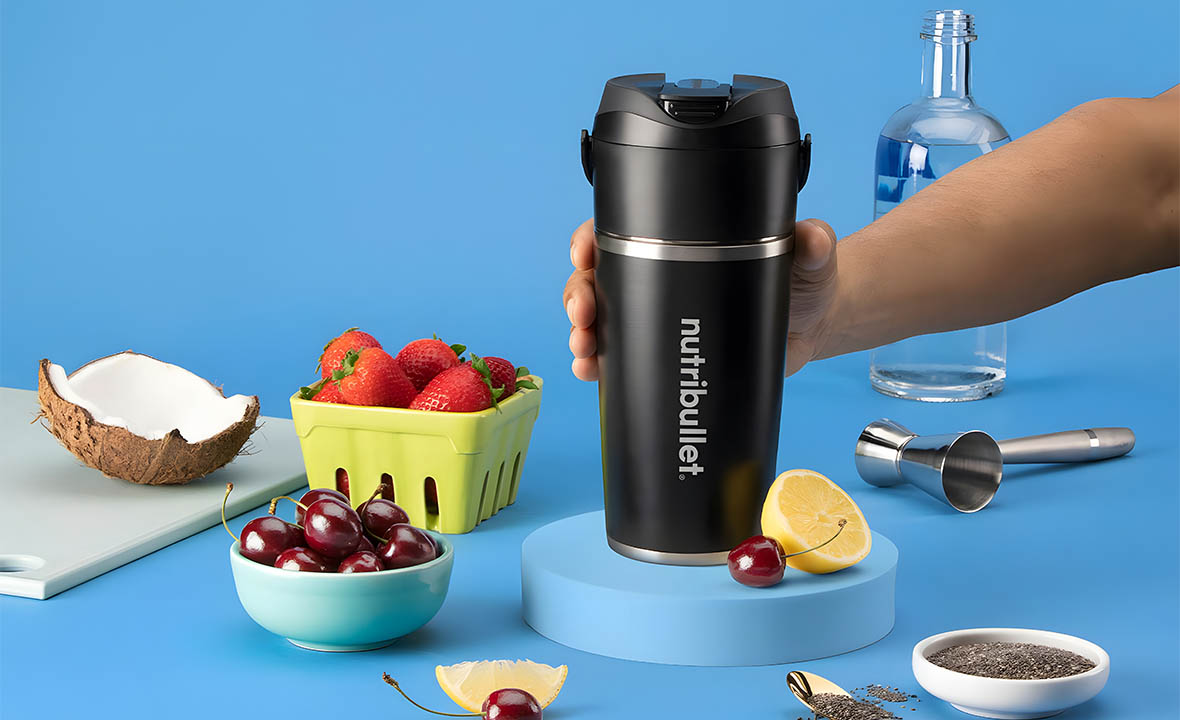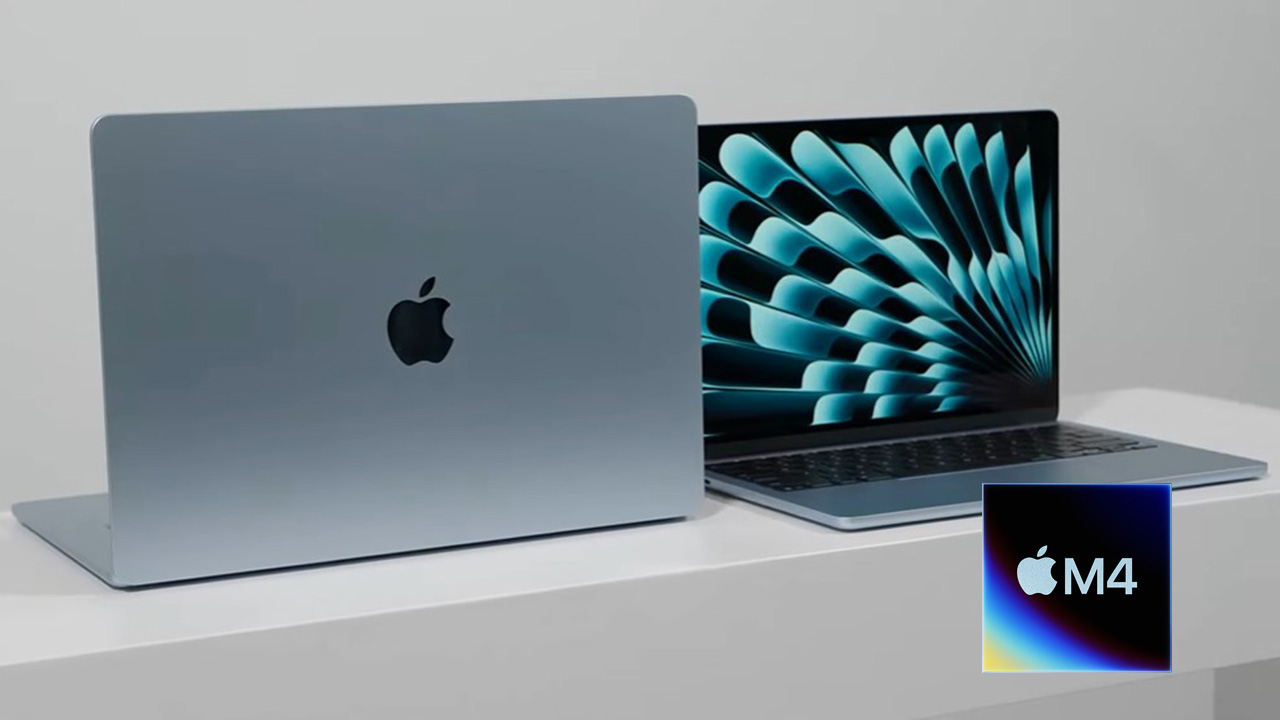Insta360 Go 3 Review – Features, Specs and Price
Insta360 Go 3 is the latest version of the company’s smallest and most affordable action camera. It replaces the Insta360 Go 2 and aims to provide casual content creators and vloggers with a portable and travel-friendly tool for high-quality video. Like its predecessor, the Go 3 prioritizes size, portability, and wearability, allowing you to effortlessly document your adventures.
The Go 3 improves upon certain aspects of Insta Go 2, including video performance and recording modes. It also introduces significant changes compared to the earlier model. The previous case, which served as a case/remote/grip, has been replaced by an Action Pod that transforms the Go 3 into a more traditional action camera in terms of both appearance and functionality, opening up genuine vlogging possibilities.
The action camera market is highly competitive, and Insta Go 3 faces strong competition, such as the renowned GoPro Hero11 Black, which sits at the top of our list of the best action cameras. In terms of size, it competes with the GoPro Hero11 Mini. However, each of these cameras has its own strengths and intended uses, which means the compact Go 3 might be perfect for you. Therefore, we have extensively tested it in various scenarios to help you determine if it meets your needs. Continue reading to find our comprehensive Insta360 Go 3 review.
INSTA360 GO 3: Price and Availability
The Insta360 Go 3 was released for sale on 27th June 2023 and can be purchased worldwide through the Insta360 store and authorized retailers, including Amazon. The company offers three storage options for the camera: 32GB ($379), 64GB ($399), and 128GB ($429). Each model comes with the Action Pod, Magnet Pendant, Easy Clip, Pivot Stand, and Lens Guard.
Insta360 also provides a wide range of accessories and mounting kits. We tested the 2-in-1 mini tripod and selfie stick ($29), the motorcycle mount bundle ($45), the helmet mount bundle ($19), and the standalone quick release mount ($34). The tripod includes a version of the quick release mount that utilizes a ¼” thread. It is important to carefully consider whether the standalone quick release mount is necessary when purchasing any accessories or mounting bundles. Some accessories use the ¼” thread, while others utilize the tilting fork attachment system of the standalone quick release mount. For example, the motorcycle bundle is compatible with the ¼” thread mount, whereas the helmet bundle works with the tilting fork mount. All the accessories we tested made use of the excellent magnetic mounting system to attach to the Go 3’s Action Pod, and they felt durable and of high quality.
Keep in mind that the Go 3 does not have expandable storage, so choose your storage option wisely. By comparison, the GoPro Hero 11 Black is priced at $399, but you need to provide your own storage. For reference, our 64GB test version was capable of recording a maximum resolution 2.7K video for 2 hours and 50 minutes. Therefore, you can effectively halve or double that recording time for the other versions.
INSTA360 GO 3: Specs
Aperture
F2.2
35mm Equivalent Focal Length
11.24mm
Photo Resolution
2560×1440 (16:9)
2560×2560 (1:1)
1440×2560 (9:16)
2936×1088 (2.7:1)
Video Resolution
Video
2.7K: 2720×1536@24/25/30fps
1440P: 2560×1440@24/25/30/50fps
1080P: 1920×1080@24/25/30/50fps
FreeFrame Video
1440P: 2560×1440@24/25/30/50fps
1080P: 1920×1080@24/25/30/50fps
Timelapse
1440P: 2560×1440@30fps
TimeShift
1440P: 2560×1440@15/30fps
Slow Motion
1080P: 1920×1080@120fps
Pre-Recording
2.7K: 2720×1536@24/25/30fps
1440P: 2560×1440@24/25/30/50fps
1080P: 1920×1080@24/25/30/50fps
Loop Recording
2.7K: 2720×1536@24/25/30fps
1440P: 2560×1440@24/25/30/50fps
1080P: 1920×1080@24/25/30/50fps
Photo Format
INSP (can be exported via App or Studio)
DNG (can be exported via App or Studio)
Video Format
MP4
Photo Modes
Photo, HDR Photo, Interval, Starlapse
Video Modes
Video, FreeFrame Video, Timelapse, TimeShift, Slow Motion, Pre-Recording, Loop Recording
Color Profiles
Standard, Vivid, Flat
Weight
GO 3: 35.5g (1.25oz)
Action Pod: 96.3g (3.40oz)
Dimensions (W x H x D)
GO 3: 25.6×54.4×23.2mm (1.0×2.1×0.9in)
Action Pod:
Screen Folded: 63.5×47.6×29.5mm (2.5×1.9×1.2in)
Screen Unfolded: 63.5×86.6×29.9mm (2.5×3.4×1.2in)
Video Coding
H.264
Max. Video Bitrate
80Mbps
Gyroscope
6-axis gyroscope
Exposure Value
±4EV
Color
White
Compatible Devices
iOS Devices:
Compatible with iOS mobile devices with chips A11 or above and iOS version 11.0 or above, including iPhone SE 2, iPhone 8, iPhone 8 Plus, iPhone XR, iPhone XS, iPhone XS Max, iPhone X, iPhone 11, iPhone 11 Pro, iPhone 11 Pro Max, iPhone 12, iPhone 12 Pro, iPhone 12 Pro Max, iPhone 12 mini, iPhone 13, iPhone 13 Pro, iPhone 13 Pro Max, iPhone 13 mini, iPhone 14, iPhone 14 Pro, iPhone 14 Pro Max, iPad Air (2020), iPad Pro and newer iPad models.
Android Devices:
Compatible with Android mobile devices that meet the following capabilities, including:
- Android devices with Kirin 980 and above chips, including Huawei Mate 20, P30 or newer models.
- Android devices with Snapdragon 845 and above chips, including Samsung Galaxy S9, Xiaomi Mi 8 or newer models.
- Android devices with Exynos 9810 and above chips, including Samsung Galaxy S9, S9+, Note9 and newer models.
- Android devices with Tensor chips, including Google Pixel 6.
Note:
- Devices that do not meet the above requirements may still be able to use the app to control the camera, however, performance of some processor-intensive and AI-powered features may be sub-optimal.
- After testing, phones equipped with Qualcomm SDM765 5G chips have poor hardware decoding capabilities and are not supported for use, such as OPPO Reno 3 5G.
- App installation requires a mobile phone with a 64-bit system. A 32-bit system does not support app installation.
ISO Range
100-3200
Shutter Speed
Photo: 1/8000 – 120s
Video: 1/8000 – to the limit of frames per second
White Balance
Auto, 2000 – 10000K
Audio Modes
Wind Reduction, Stereo, Direction Focus
Audio Format
48Khz, 24bits, AAC
Bluetooth
BLE 5.0
Wi-Fi
5GHz
802.11a/n/ac
USB
Type-C
Storage
32GB, 64GB, 128GB
Battery Capacity
GO 3: 310mAh
Action Pod: 1270mAh
Charging Method
GO 3: Action Pod
Action Pod: Type-C
Charging Time
GO 3: 23 mins to 80% | 35 mins to 100%
Action Pod: 47 mins to 80% | 65 mins to 100%
Run Time
GO 3: 45 mins
GO 3 + Action Pod: 170 mins
*Tested in 25°C (77°F) lab conditions at 1080p@30fps in “Video Mode”, with screen and Wi-Fi off. Run time may vary in different conditions.
Use Environment
GO 3: -4°F to 104°F (-20℃ to 40℃)
Action Pod: -4°F to 104°F (-20℃ to 40℃)
INSTA360 GO 3: Design
Insta360 has always been known for its clever designs, but the Go 3 is perhaps its most intriguing creation yet.
Similar to the Insta360 Go 2, the camera module of the Go 3 is smaller than your thumb. It’s a compact oval-shaped device with a lens on one end and a built-in button on the body.
While Insta Go 2 snapped into a case resembling AirPods, the Go 3 docks into a housing called the Action Pod, transforming the entire setup into something that resembles a GoPro. The Action Pod features a large 2.2-inch touchscreen that can flip up vertically, allowing you to frame yourself in the shot. This is a feature you won’t find on its similarly-sized competitor, the GoPro Hero11 Mini, making the Go 3 a superior choice for vlogging. During our testing, the screen proved extremely useful for aligning the device when mounting it on an accessory, ensuring that everything remained properly composed, especially with the availability of a 3×3 composition grid. When we mounted it on our motorcycle, it was effortless to flip up the screen and double-check if everything was still properly aligned—of course, while we were safely stopped.

The Go 3 can be recharged and controlled through the Action Pod’s screen, as well as with the large Record button on top. The Action Pod also includes a power button and a quick record button on its left side, along with a USB-C port on the right. Cleverly, you can also use the Action Pod as a remote control, eliminating the need to take out your phone to change camera settings or view the recording. The Go 3 attaches to the Action Pod through a strong magnet and secures with a satisfying click. It remains securely locked, requiring you to press an unlock button to remove it. One issue we encountered during testing was that removing the Go 3 from the Pod involved pressing the release button and pulling on the lens surround since there wasn’t a pull tab. This may not be a problem and could be the intended method of removing the camera, but it felt a bit awkward.
As a combined unit, the Go 3 and the Action Pod weigh 4.65 ounces and measure 2.5 x 1.9 x 1.2 inches. Remarkably, this makes it both smaller and lighter than the similarly priced Hero11 Black (5.4 ounces, 2.8 x 2 x 1.3 inches). The Go 3 also comes with a magnetic cap peak mount for using the camera on its own, demonstrating just how lightweight the unit is. During our testing, we attached it to the peak of an old, loosely-fitting tennis hat, and it didn’t cause the hat to sag or move around as we moved.
The bottom of the Action Pod is equipped with magnetic clip attachments on both ends, allowing it to securely attach to quick release mounts using magnetic hooks. When connected to the provided mount, it exhibits surprising strength despite its small size and requires pressing an unlock button to release the Action Pod. This system works exceptionally well and instills confidence even when attached to the side of a helmet at high speeds on the freeway. Overall, the design of the Go 3, coupled with the wide range of official and affordable accessories available, makes it an excellent camera for various use cases, including sports, adventure, vlogging, motoring, and even as a dash cam or security camera.
One notable trade-off between the Go 3 and the GoPro is that the Go 3 lacks expandable storage. Once you run out of space on the camera, you’re out of luck. However, in a pinch, you can simply export the high-resolution files directly to your phone and then clear the camera’s storage to start afresh.
The Go 3 is not as rugged as the GoPro. While the Go 3’s camera can be submerged up to 5 meters in water, the Hero11 Black can withstand depths of up to 10 meters. GoPro features a 3.5mm audio jack for connecting an external microphone, whereas the Go 3 does not support any external audio input, meaning you are limited to using the two onboard microphones. Granted, this may not be a significant issue for most of the target audience who wear the Go 3 on their cap peak or around their neck while walking or exploring.
INSTA360 GO 3: Video Quality
Insta360 Go 3 is equipped with an ultra-wide-angle 11.2mm (full frame equivalent) f/2 lens, allowing you to capture a broad field of view. It offers four field of view modes (ultra-wide, action, linear, and narrow), which gradually decrease the field of view. This means you’re not limited to the fisheye ultra-wide perspective and can customize the look of your footage according to your preferences or requirements. The camera can shoot in both landscape and portrait orientations, making it suitable for YouTube videos, TikTok clips, and other social media content.
Similar to the Hero 11 Black, the Go 3 features a FreeFrame Mode that supports up to 1440p resolution, enabling you to adjust the aspect ratio of your video after capturing it. It also offers image stabilization, now available at the enhanced maximum resolution of 2.7K and 30fps. You can choose from three levels of stabilization, depending on the intensity of the activity you’re engaged in. Applying more stabilization may introduce a slight delay in the video preview. The 1440p resolution can be shot at 50fps for smoother footage. There’s a 1080p mode that allows for longer recording durations. However, in terms of overall resolution, the Go 3 falls far behind the Hero 11 Black, which can record video in 5.6K resolution at 30fps.
Video Credit: Insta360
When shooting at 2.7K resolution, our Go 3 had no video recording limits until the battery drained, although the footage was divided into 30-minute segments. Essentially, this means there’s no time constraint on recording at the maximum resolution, and your only limitations are the battery life and available storage space.
The camera’s automatic metering does an excellent job of ensuring proper exposure, even on bright days. In our test footage while motorcycling, you can observe the camera quickly and accurately adjusting as we transitioned from shaded areas to bright light. There’s a manual mode available both on the camera itself and the smartphone app, allowing you to adjust basic parameters such as color mode, ISO, shutter speed, and white balance. We found that leaving it on auto mode yielded satisfactory results.
For shooting in slightly dimmer lighting conditions, there’s a low light stabilization mode that helps reduce motion blur caused by the camera’s auto mode slowing down the shutter speed. You should avoid using this mode in excessively dark situations as it may excessively reduce image brightness. Generally, low light video performance is subpar, even with the low light stabilization. This is to be expected from a camera of this size with a small image sensor. If you plan on doing a lot of nighttime vlogging, the Go 3 is not the ideal tool. In my testing, during the day in a room darkened by drawn curtains, intense noise was noticeable in automatic mode, which significantly affected image quality.
The Go 3 also allows you to shoot 1080p video in slow motion at 120fps, although it is oddly limited to a 9:16 portrait orientation. There are two photo modes available: HDR and normal. These modes are quite basic. While you can adjust exposure settings manually, you have no control over the focus area. Realistically, the photo mode would only be used when necessary, as you’d likely achieve better results using your phone instead.
INSTA360 GO 3: Audio Quality
When recording in a quiet environment, the Go 3’s dual internal microphones captured and transmitted voices clearly. It achieved a good balance of sound, making whispers audible and minimizing distortion when shouting. The camera offers directional focus and stereo modes, allowing you to customize the microphone setup according to your environment and goals.
The absence of an external microphone port does limit the “action” aspect of the “action cam” to some extent. When wearing the Go 3 during high-speed activities like cycling or motorcycling, there will be a significant amount of wind noise in the footage. While there is a Wind Reduction mode, our testing revealed that it couldn’t effectively reduce strong wind noise from motorcycling and couldn’t capture my voice clearly while riding. If you want to record clean spoken audio while using the Go 3 at high speeds, you’ll need to use a separate external microphone and synchronize the audio in post-production.
The lack of an external microphone port is a notable limitation of the Go 3, as it would have enabled better results in a wider range of action scenarios. It is perhaps the camera’s most significant drawback.
INSTA360 GO 3: Apps & Features
Insta360 app easily connects to the Go 3, allowing you to have full control over the device from your smartphone. You can use the app to shoot tethered, adjusting exposure parameters and styles directly on the screen. Alternatively, you can shoot solely on the device and then connect to the app to export and edit your footage. (Note: If you prefer editing on a computer workstation, you can also connect the Go 3 directly to a computer and transfer media files.)
Initially, we encountered some difficulties in connecting and pairing the Insta360 app via Bluetooth and Wi-Fi. It could be a bit finicky, and there were also some issues with maintaining a connection during the export process, as the app would occasionally disconnect. It’s important to note that we were using a test version of the app during our pre-launch testing of the Go 3. After a firmware update, these issues were completely resolved, and the stability of the pre-launch test app improved significantly.
Within the smartphone app, you’ll find a range of color filters that you can apply to your videos before shooting. These filters include options specifically designed for biking, ocean scenes, and nighttime footage. They allow you to be creative with your content based on the type of action you’re capturing and save you the trouble of editing colors in post-production. In the vivid mode, colors appear vibrant and appealing. When we tested it on a sunny day, it accurately reproduced deep blue skies, warm red and orange tones, and vivid greens. The footage felt natural and not overly saturated.
The app provides various editing options for your recorded footage. You can add filters, trim clips, take snapshots, mirror the video, adjust color settings, and add music. You have access to standard exposure controls, temperature and hue adjustments, face filters, and a freeze frame tool. The freeze frame tool is particularly useful, allowing you to hold a specific frame on the screen for 3, 5, or 10 seconds, which is handy for drawing attention to certain elements in your footage. Overall, the Insta360 app is an effective tool for quick editing and uploading of content, offering an alternative to more complex and expensive video editing software.
Insta Go 3 introduces new recording modes that are available both in the app and standalone camera mode. These include Pre-recording, Loop Recording, and Timed Capture. Timed Capture, also found in the Hero 11 Black, enables you to schedule the Go 3 to turn on and start recording at a specific time. This is useful for capturing star lapses without needing to wake up at 3 a.m.
Loop Recording allows continuous filming for a predetermined interval, such as 30 minutes or an hour, before overwriting the oldest footage. This feature is ideal for using the Go 3 as a dash cam in motor vehicles, in conjunction with the Car Mount ($39) or the Helmet Mount ($19). Pre-recording is great for fast-paced situations like family gatherings. In this mode, the camera continuously records footage before you even press the record button, ensuring that you don’t miss any moments if your reaction time is slightly delayed. These features are not mere gimmicks but rather highly practical and useful in real-world scenarios.
INSTA360 GO 3: Battery life
One limitation of the Insta360 Go 2 was that video clips were limited to 30 minutes in length, but only when the camera was in a windy environment. In other cases, it was recommended to keep the limit to 15 minutes to prevent the camera from overheating. This posed a challenge when we attached Insta Go 2 to our cat, as his wanderings often exceeded the camera’s time limit.
The Go 3, however, no longer has this limitation thanks to a new heat dissipation design. During our testing with the camera in its Action Pod (which acts as a secondary battery), we were able to record continuously until the battery ran out, albeit in consecutive 30-minute videos. That’s a total of 170 minutes! It’s worth noting that the Go 3 does become slightly warm to the touch during extended recording.
In our tests, recording at maximum resolution in standard Video mode with the 64GB version, we achieved just over 2 hours and 50 minutes of recording time, which is a decent amount of content and essentially matches the camera’s battery life (when used with the Action Pod). However, using FreeFrame Video mode will reduce your recording time by almost half, as it requires more storage space, but it won’t have a significant impact on your battery life.
INSTA360 GO 3: Verdict
There’s no point in creating an action camera that’s essentially a copy of a GoPro. It simply won’t be able to compete. What Insta360 has done, and quite successfully in our opinion, is to create a series of cameras that offer something different from GoPro. This includes 360 cameras and compact cameras like the Go 3, which, due to its small size, allows you to have some fun, such as attaching it to your cat.
If you’re looking for an action camera to capture professional-grade videos, the Go 3 is not the right choice, nor was it designed to be. In that case, you’d want to invest a similar amount of money in a GoPro Hero11, which allows you to shoot 5.3K video at 60p in 10-bit color, connect an external microphone, and even take it underwater. Alternatively, if you’re willing to spend a bit more, the Insta360 X3 offers all of the above and even includes the impressive “floating” third person mode.
If you’re looking for a lightweight and portable video camera to accompany you on adventures, sports activities, and vlogging, with enough capabilities to produce good-looking videos with minimal effort, then the Go 3 is a compelling little package.







